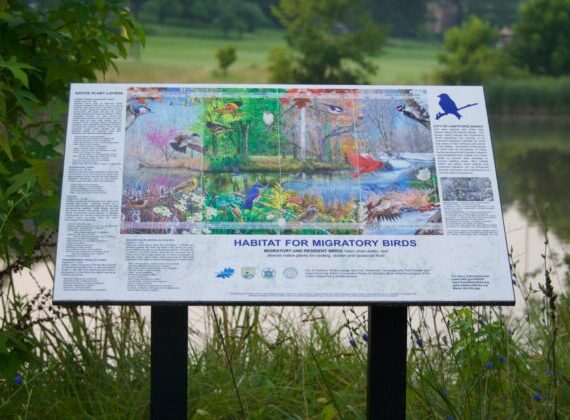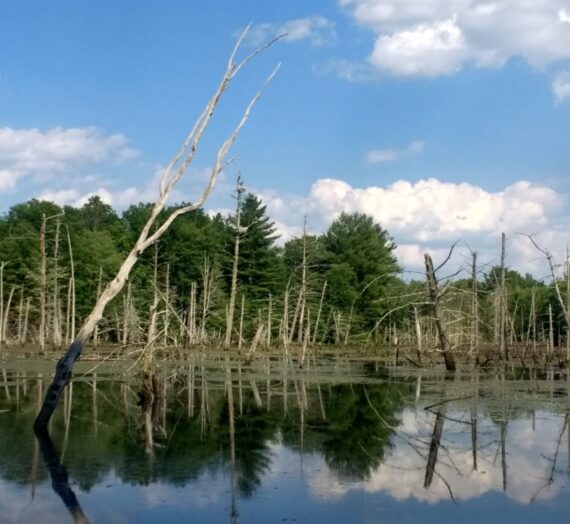In 2019, the Connecticut Science Center opened its climate change exhibit, with one part of it being rescue equipment. sending a strong message: things are scary and going to get scarier — at least until we start seriously managing ourselves better.
Why, in 2024, do events obviously linked to climate change still seem to stun Connecticut residents when they happen here?
In part, it is what’s not named in the reporting of them.
In January 2024, about 500 residents in eastern Connecticut were evacuated, not because of a blizzard, but due to flooding. The Courant gave this incident a lot of words, none of them being “climate change.”

This is not asking for apocalyptic weather reports. There are already plenty of those, with the bright red ALERT banners on websites and dramatic music. It’s not a matter of scaring people into action, but being honest by connecting dots.
Climate scientists have been criticized by others in the field for being overly cautious when it comes to communicating how climate change is happening; I’ve heard the problem explained this way: scientists in talking with other scientists understand the norms of their field, and when they turn to communicate with the non-science community public, have not tailored their language for the different audience.
Treating STEM as more important than the humanities instead of needing to be woven together has not helped matters.
What we have gotten has been, too often, reporters not understanding the nuance of science communication and in turn either framing climate change as being more debatable than it is, or skirting the issue entirely.
A disaster is a disaster, right?! Why does it matter if we say that it is more likely than not the result of climate change?
If we have any interest in mitigating and eventually reducing the severity of these events, people need to make the connections.

The heavy rains last January, besides prompting evacuation orders in Norwich and Bozrah, led to the emergency rescue of two people trapped in a Norwich Domino’s, closed several schools, and closed parts of state roads in 17 towns: Windsor, Southington, Woodstock, Pomfret, East Hampton, Hebron, Lebanon, Franklin, Sprague, Bozrah, Lisbon, Washington, Ridgefield, Roxbury, New Milford, Redding, Danbury, and Woodbury. Businesses were damaged. Thousands lost power.
The heavy rains this month were linked to the deaths of two women in Oxford and to a man found days later in Westport, about a mile downstream from where his vehicle was found on the Weston/Fairfield border. There were 100 people evacuated in Danbury, plus a dozen emergency rescues there; 46 people were rescued from Kettletown State Park in Southbury. Another 30 needed an emergency boat rescue at Lake Zoar in Oxford. In that same town, another dozen needed rescue from a restaurant and a house, this time by firetruck ladder. Thirty CTtransit bus passengers needed a rescue after their ride was stranded by a flooded out road and some railroad tracks. Numerous stranded vehicles needed to be recovered.
Over one million Connecticut residents lost power. Multiple state parks closed, with some remaining so over a week later: Southford Falls State Park and Kettletown State Park among them.
Farms were damaged. Exactly one month before this weather event, CT Insider ran a piece about how some farmers were still waiting for the aid they were promised to assist with damages incurred during mid-July 2023. Aid does not reach those who need it soon enough, and as storms increase in frequency and intensity, it doesn’t take a mathologist to understand that at some point there won’t be funds to bail out damaged businesses. Working to prevent the severity of future storms is a more logical approach.
Oxford delayed the start of its school year from August 28 to the “earliest possible start” being during the following week
Service was temporarily suspended on the Metro-North Danbury Branch. Because of a mudslide in Ansonia and Seymour, the Metro-North Waterbury Branch has been closed since August 18, 2024 and remains so at time of publication.
A rock slide closed a state road in Ansonia while washouts did the same to state roads in Woodbury, Oxford, Monroe, Newtown, and Southbury. Flooding in those same towns closed state roads there and in Bethel, Ridgefield, Bridgewater, Redding, Seymour, and Danbury. This does not account for where town roads and private roads were closed. A week later, ten miles of state roads remain closed in Southbury, and sections from several other roads have not reopened, with some expected to be long term closures. It’s hard to call this entirely unprecedented when earlier this year, some of those places were impacted with closures from flooding. It’s a different scale, but this most recent man-made disaster did not come without any warning.
This time though, climate change was named. The irony is that earlier on August 18th, the Courant ran a piece about how more inland towns are finally confronting their need to prepare for climate change; it was then updated the following afternoon (hence, what appears to be an inaccurate publication date). It’s not revolutionary and could do more questioning of building practices, but it does acknowledge that “20% and 46% of flood damages across the country are from increasing precipitation” and cites an expert who lays it out that by “developing more and more and putting more hard pavement down,” what we get is “greater runoff, so our vulnerability to extreme flooding is increasing.”
Two days after the August floods, the Courant ran another long piece about what happened. Here, finally, the magic words were uttered in the form of a quote by the DEEP commissioner. She called the heavy rainfall to be “consistent with the accelerating impacts of climate change as we’re experiencing.”
CT Insider ran an article that got deeper into the science, acknowledging that “one-third of inland flood damage is due to climate change,” and that while “extreme precipitation days have intensified in all regions of the country, […] the biggest surge was found in the Northeast.”
Naming the culprit is not about feeding despair — it’s working toward understanding the problem so that we allow and fund appropriate solutions.
If water is framed as the villain, then people believe that the answer is some version of the lazy, hubristic, and broken approach that we have seen for the last century plus: add more concrete. As a Penn State professor explains, “modern urban drainage systems began by whisking the water away at the risk of extreme flooding downstream.” This takes along the poisons people spray on lawns, pollution from brakes and tires, and more.
When we recognize the role that we play in causing more frequent and intense floods, then we can better see the range of tools available to us from permeable pavement, rain gardens, and wetlands restoration projects, but also solar and wind power, while moving away from fossil fueled everything as if it were a flaming bag of poop.
While reporting has improved on this issue, somewhat, at the Courant and Hearst, and among some online-only sources, the television news that people get exposed to at the bank and dentist office, and while ironing their clothes, have not gotten with the program yet. All it would take is for them to trust and respect their viewers.


